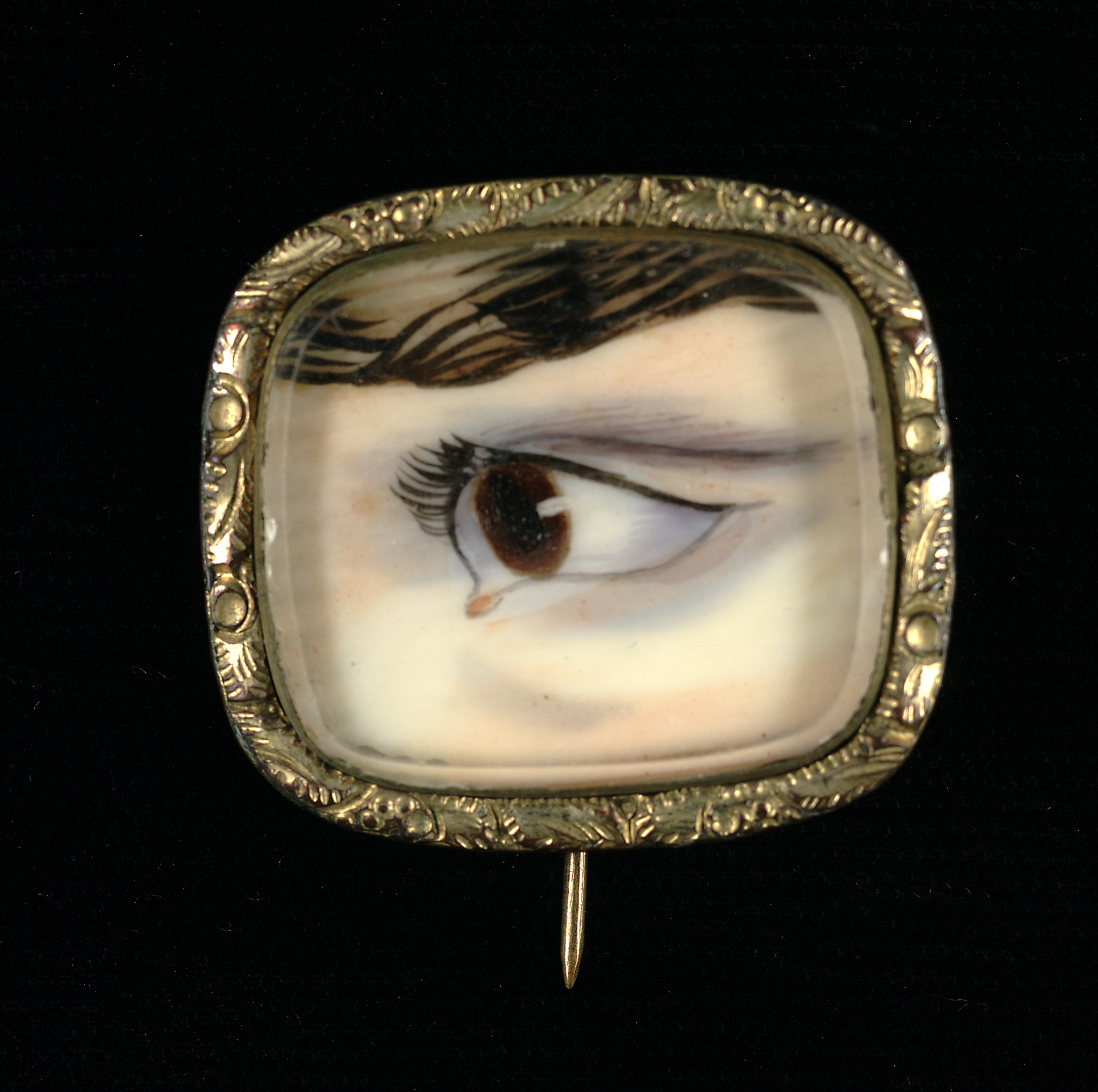Citation
Chicago:
Maggie Keenan, “Unknown, Eye Miniature, early 20th century,” catalogue entry in Aimee Marcereau DeGalan, Blythe Sobol, and Maggie Keenan, The Starr Collection of Portrait Miniatures, 1500–1850: The Collections of the Nelson-Atkins Museum of Art, vol. 1, ed. Aimee Marcereau DeGalan (Kansas City, MO: Nelson-Atkins Museum of Art, 2024), https://doi.org/10.37764/8322.5.4110.
MLA:
Keenan, Maggie. “Unknown, Eye Miniature, early 20th century,” catalogue entry. Aimee Marcereau DeGalan, Blythe Sobol, and Maggie Keenan. The Starr Collection of Portrait Miniatures, 1500–1850: The Collections of the Nelson-Atkins Museum of Art, edited by Aimee Marcereau DeGalan, vol. 1, Nelson-Atkins Museum of Art, 2024. doi: 10.37764/8322.5.4110.
Catalogue Entry

Although we do not know the artist for this left-eye miniature and its pair (Fig. 1, F58-60/198), they were painted by the same hand. A single beauty mark in the corner of one differentiates it from the other; beyond that, they appear virtually identical. Both are set in rings from the early 1800s with red cut-stone surrounds. Garnets were popular settings for lover’s eyes, called the “most desirable gemstone of Georgian day jewellery” due to its affordability, attractiveness, and association with felicity and friendship.1Charles Welsh, The Language, Sentiment, and Poetry of Precious Stones (New York: Platt and Peck, 1912), 10, 11, 58, 126; Ginny Redington Dawes and Olivia Collings, Georgian Jewellery 1714–1830 (Woodbridge: Antique Collectors Club, 2007), 120. The eyes also share the same sweeping eyebrow with textured marks of dark brown, as well as simplified lines comprising the black arc of the upper lid, a half circle outlining the inner tear duct, and an orange stripe to designate the lower lid’s waterline. The blue irises gleam, highlighted with added dashes of white. A hint of blush appears at the bottom edge of both miniatures, indicating a slight flush to the cheek. These colors combine to enliven these diminutive yet tender compositions.

The most convincing evidence that the same artist painted both eye miniatures is a shared stroke of gum arabic: Derived from the sap of the African acacia tree, gum arabic was commonly used to bind watercolor pigments with water. In addition to its use as a binder, miniaturists capitalized on its glossy effect to create areas of highlight with larger quantities of gum. As with ivory, its availability benefited from trade routes that were expanding due to colonialism and the Atlantic slave trade. across the right edge of each pupil. A similar technique appears across the right edge of the pupil in a brooch at the Smithsonian American Art Museum, quite possibly linking all three eye miniatures (Fig. 2).2This argument is made by Elle Shushan in Lover’s Eyes: Eye Miniatures from the Skier Collection, ed. Elle Shushan (London: D. Giles Limited, 2021), 82, 84. The technique is modern; the eyes were painted in the early 1900s for a market already replete with eye miniatures.3According to a May 30-June 2, 2017 conversation with conservator Carol Aiken, notes in NAMA curatorial files. Graham Boettcher discusses the revival of eye miniatures, first in the early 1900s, then briefly in the 1940s and 1950s, and then again in the 2000s, in his essay “Love Never Dies,” in Shushan, Lover’s Eyes, 93–115. For a genre in which it is so impossible to identify sitters or artists, classifying similar stylistic approaches—and therefore the same artist’s hand—is the closest one can usually come to an attribution.4The rare exceptions are eye miniatures securely attributed to George Engleheart (1750–1829) and John Cox Dillman Engleheart (1784–1862). The anachronistic effect of nineteenth-century paintings placed within settings from a century earlier is jarring, especially when combined with the image’s own disembodiment: an eye disassociated from the context of a surrounding portrait.5Dawes and Collings, Georgian Jewellery, 176–77.
Notes
-
Charles Welsh, The Language, Sentiment, and Poetry of Precious Stones (New York: Platt and Peck, 1912), 10, 11, 58, 126; Ginny Redington Dawes and Olivia Collings, Georgian Jewellery 1714–1830 (Woodbridge: Antique Collectors Club, 2007), 120.
-
This argument is made by Elle Shushan in Lover’s Eyes: Eye Miniatures from the Skier Collection, ed. Elle Shushan (London: D. Giles, 2021), 82, 84.
-
According to a May 30–June 2, 2017, conversation with conservator Carol Aiken, notes in NAMA curatorial files. Graham Boettcher discusses the revival of eye miniatures, first in the early 1900s, then briefly in the 1940s and 1950s, and then again in the 2000s, in his essay “Love Never Dies,” in Shushan, Lover’s Eyes, 93–115.
-
The rare exceptions are eye miniatures securely attributed to George Engleheart (1750–1829) and John Cox Dillman Engleheart (1784–1862).
-
Dawes and Collings, Georgian Jewellery, 176–77.
Provenance
Mr. John W. (1905–2000) and Mrs. Martha Jane (1906–2011) Starr, Kansas City, MO, by 1958;
Their gift to The Nelson-Atkins Museum of Art, Kansas City, MO, 1958.
References
Ross E. Taggart, The Starr Collection of Miniatures in the William Rockhill Nelson Gallery (Kansas City, MO: Nelson Gallery-Atkins Museum, 1971), no. 219, p. 72, (repro.), as Eye Miniature.
Elle Shushan, ed., Lover’s Eyes: Eye Miniatures from the Skier Collection (London: D. Giles, 2021), 82, 84.
No known exhibitions. If you have additional information on this object, please tell us more.